Brand mentions have always seemed to play the supporting role in SEO.
We loved them because they made it easier to secure actual backlinks.
And 80.9% of SEOs who took part in our State of Link-Building 2025 study believe they influence rankings.
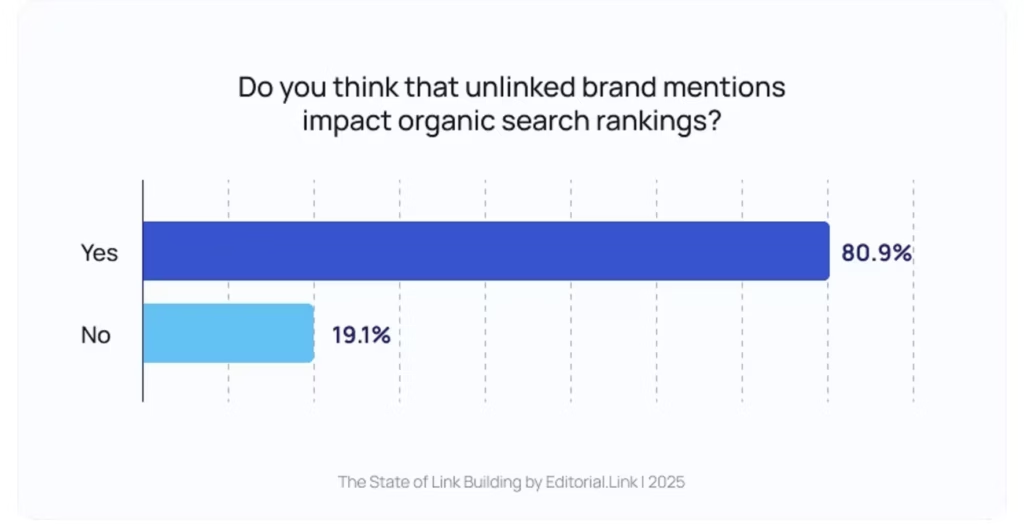
But they’ve never been a goal in their own right.
The rise of AI search is flipping the script altogether, though.
Google’s AI Overviews, Bing Copilot, Perplexity, and ChatGPT can surface a company purely based on the strength of its mentions — no backlinks required.
And it’s a trend you can’t ignore.
Brands that appear in AI Overviews for transactional queries get 3.2 times more clicks than those in traditional SERP results.
Semrush estimates that LLM referral traffic is worth 4.4 times more than organic traffic because more and more people use AI to research products.
In the article, I will share the best tactics for securing relevant brand mentions — ones we’ve seen deliver again and again.
I will also explain how to track the impact of brand mentions and how to adjust your link-building strategy to land precious web mentions.
Why Brand Mentions Matter for AI Search?
If you want your brand to be cited in AI responses, it must be mentioned on the pages that it uses as sources.
You’ve seen the data: Ahrefs' study of 75K brands found that branded web mentions, including branded backlinks, had the strongest correlation with brand appearance in AI overviews.
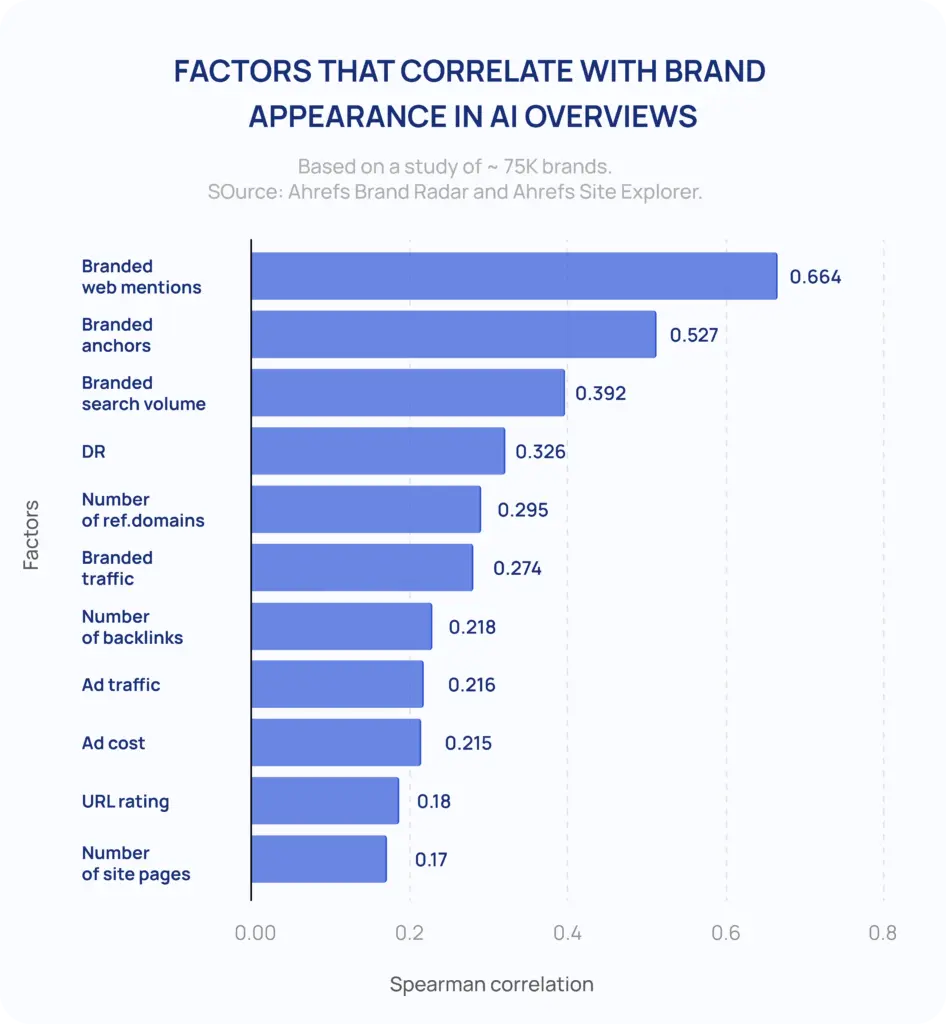
While we don’t know exactly how they evaluate content, the available data suggests that they use mentions by respected media, expert blogs, or industry sites to determine brand trustworthiness.
And relevance.
LLMs judge how semantically close concepts are to understanding relationships between them. This means that for your brand to be recommended in commercially valuable AI responses, you must build strong associations between your brand and relevant topics. Through widespread mentions.
‘Widespread’ is crucial here.
Being unique was an advantage in traditional search. It isn’t in AI search.
Brands and ideas may remain invisible to LLMs unless they’re widely covered across multiple sources. Because the model won’t be able to pick patterns.
This means new or smaller brands will struggle to gain visibility in AI search results.
Brand Mentions vs Backlinks: The Overlap
Brand mentions and backlinks have always been closely tied: a backlink with a branded anchor text is also a brand mention.
Brand mentions also make it easier to secure backlinks. If the prospect already knows about your brand — and talks about it in their content — they are easier to convert.
Because you don’t have to convince them that your brand is worth featuring.
That’s why many link-builders start their prospecting by searching out unlinked mentions.
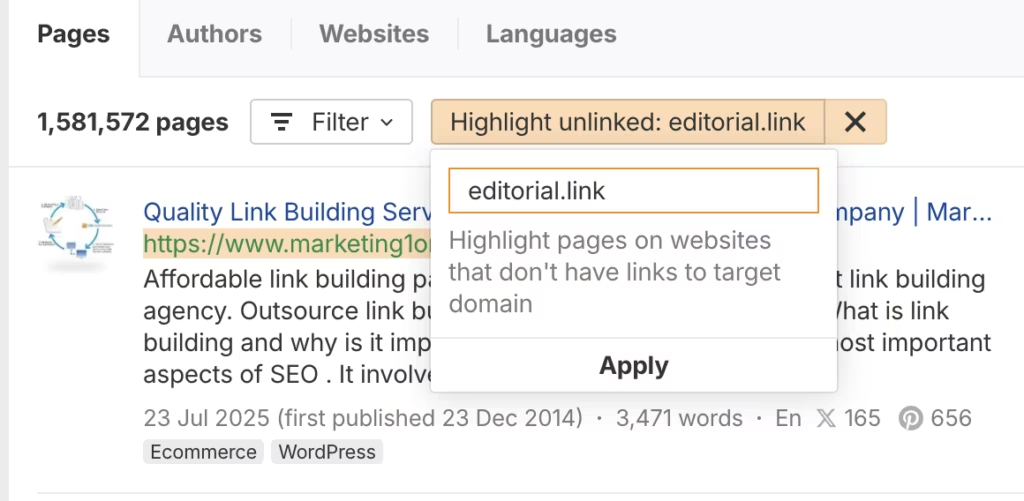
However, AI search is bringing a sort of decoupling between brand mentions and backlinks.
While backlinks still matter, an unlinked brand mention in a trusted source may be equally valuable. And often more, as shown by the data above.
What does it mean in practice?
First, it adds another dimension to prospect vetting for link building. Considering the mention alone is already benefiting your brand, is the extra effort — and often the cost — of converting it into a link worth it?
Second, you can — and must — target a wider range of websites because the sites that don’t offer backlinks can still be valuable targets if you manage to get a brand mention.
Link Building Tactics For Powerful Brand Mentions
You understand the ‘what’ and the ‘why’, so let’s get to the ‘how’: the tried-and-tested strategies for securing juicy links while snapping up those precious brand mentions.
1. Run Digital PR Link Building Campaigns
If there is one strategy that delivers quality backlinks and brand mentions at scale, it must be digital PR.
And I’m not the only one who thinks so: 48.6% of experts who took part in our study named it as the most effective link-building tactic.

How does it work?
In a nutshell, you create a newsworthy story and pitch it to journalists in your niche. Think data-rich articles, current event coverage, or expert commentary on industry trends.
All the things that your audience wants to hear — and AI can’t replicate.
Here’s the kicker:
Well-timed and relevant PR campaigns deliver not one or two links. They deliver dozens.
For example, Search Intelligence used the rumours about Taylor Swift’s engagement at this year’s Super Bowl to secure 30 links.
And not just any backlinks.
We’re talking the Mirror, New York Post, and Fox News.
Pretty impressive, isn’t it?
Links — and mentions — in such high-calibre publications are often enough to get your brand cited in AI search results.
These are highly trusted sources, after all, and LLMs use them to power their answers.
Pro tip: Check which outlets already appear as sources for queries in your niche and focus your campaign on them to increase the chances of your brand getting featured.
2. Respond to Journalist Callouts on HARO
Another way to secure links and mentions in major news publications?
Respond to journalists’ SME requests.
When a writer is after a unique angle or expert insights for their article, they send out their request via services like HARO, Qwoted, or Featured.
Here are two such requests from DR90+ domains, GoDaddy and Fast Company, on Featured.
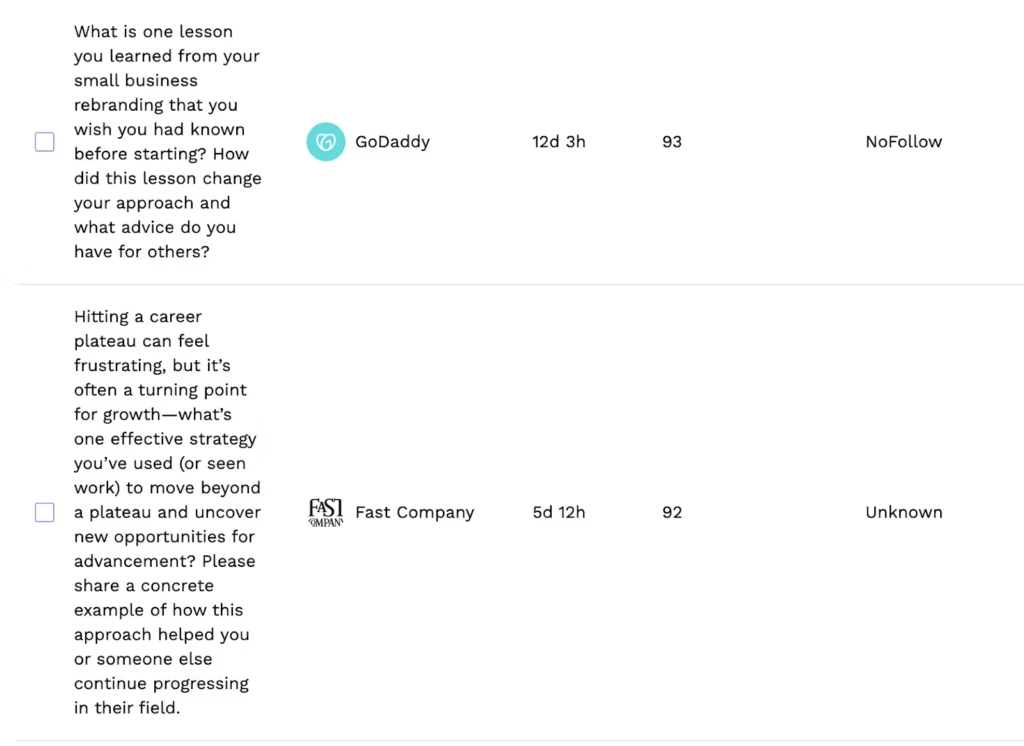
Another way to find opportunities to contribute? Monitor X and LinkedIn for requests.
Here’s one from Ankit Vora, a freelance writer seeking contributions for a Semrush article.
You fill in the form, and if he finds your insights valuable, you get a DR91 link and a mention from a highly respected and trusted source.
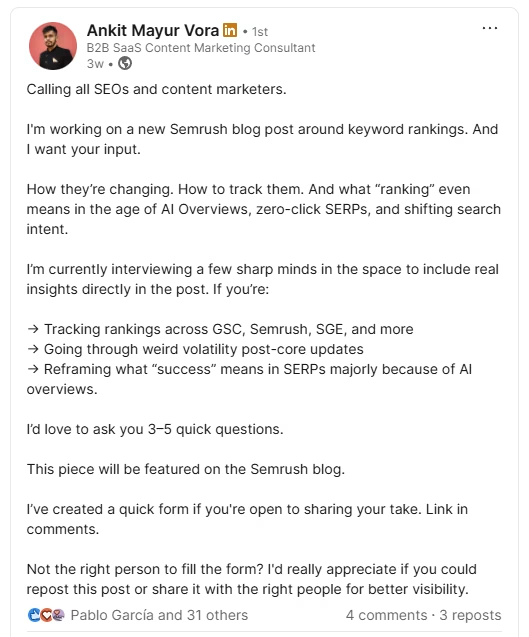
The catch?
The odds of getting featured are pretty slim. The competition is high, and you may struggle to stand out from the crowd even if you bring your A-game to the table.
How do you increase your chances?
I asked Pawel Tatarek, one of our freelance writers, who regularly uses HARO-like services.
Here are his 5 top tips:
1. Don’t use AI, even if it’s just to polish your copy. Many writers dismiss AI-written pitches by default.
2. WIY. Write it yourself. Ghostwritten pitches can work, but only when you contribute the ideas, and the ghostwriter just refines them.
3. Review the articles in the top 10 on Google and address gaps in your contribution. There’s no point in repeating something that has already been said dozens of times.
4. If there’s nothing new to add, present existing ideas in a unique and witty way.
5. Share real-life examples, like case studies, to make your ideas more tangible. And credible.
3. Be Active on Reddit
I’ll be honest with you:
When Reddit threads started wreaking havoc in SERPs, I thought it was just a short-term anomaly.
A blip in the system.
I was wrong.
A year and a half on, and Reddit is still here — even more prominent thanks to AI search!
According to Semrush data, it’s the second most cited source in AI Overviews. Right after Quora, another question-and-answer forum.

Some speculate that Reddit's success might lead to its demise.
How so?
SEOs and marketers are exploiting it massively to get cited in AI search without necessarily adding value to the community. The user activity is up, and so are the spam levels.
If the quality continues to decline, it’s possible that Google turns away from it as a source at some point.
For now, however, you can’t afford not to be active on Reddit!
The post lists link-building services, based on their personal experience, and for a website like theirs. And by doing so, it provides value to potential readers.
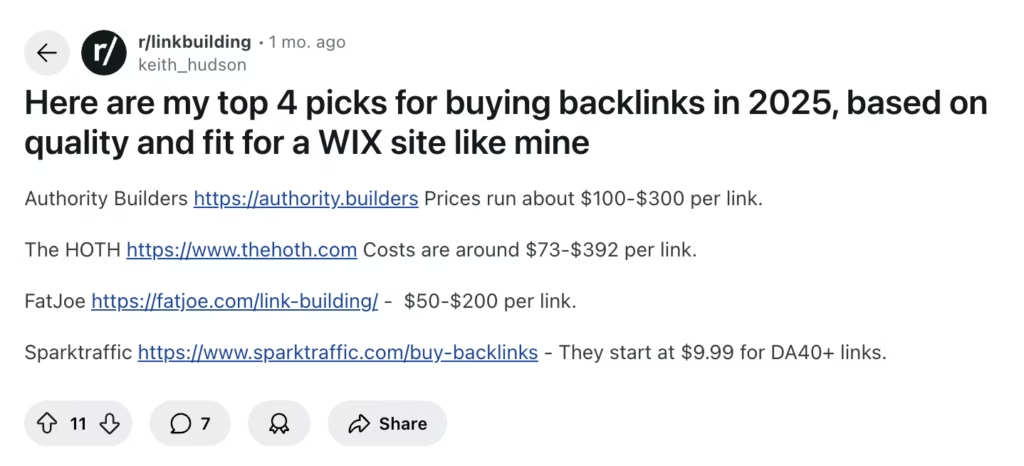
Creating such posts is far from easy, though.
If you don’t get the vibe of the thread, your post can come across as fake and spammy.
And even if the moderators don’t take it down, you will get a lot of ‘reverse-love’ from the community. Which means brand reputation damage — the exact opposite of what you’re trying to achieve.
So if I were you, I would start by contributing helpful on-topic comments to existing discussions and mentioning your brand naturally.

Editor’s note: Writers use Reddit for research. So if you’re brand appears in relevant threads, they may mention it in their articles, propelling the distribution flywheel.
How to Measure the Impact of Brand Mentions
All the big SEO tools have rolled out tools for tracking your AI search visibility. Ahrefs has the Brand Radar, Semrush has the AI Toolkit, and SE Ranking has the AI Overviews tracker.
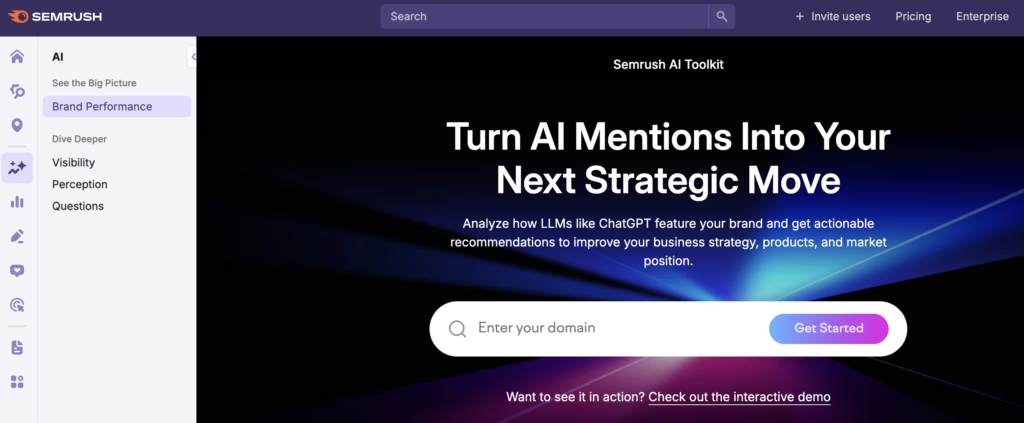
These allow you to monitor your brand’s citations in AI search results.
These are the ultimate goal — your North Star.
But it’s a lagging metric, because you have no direct way of influencing it.
Here are a few leading indicators to track in addition, so you can better shape your strategy:
- Raw brand web mention count + authority of the source
- Branded link anchors
- Branded search volume
AI citations count doesn’t give you insights into their business impact, either.
To track it, look at AI search referral traffic and conversion rates.
What to Change in Your Link Building Strategy Today
Effective SEO — I refuse to call it GEO, LMO, AEO — isn’t just about backlinks to rank your website anymore.
It’s about creating a strong brand presence.
Here’s how to achieve it:
- Move from the “dofollow link-only” mindset. Focus on brand mentions. Don’t look down on nofollow backlinks.
- Integrate SEO, PR, and community engagement to secure citations on trusted platforms and websites.
- Distribute your content across multiple channels to increase brand visibility. Think YouTube, Reddit, and social media.
- Invest in high-quality, unique content that competitors can’t replicate.
- Prioritize quality of context and authority of sites over sheer volume of backlinks/mentions.
Final Words
Brand mentions influence how often AI models cite your company in their answers, so they’re becoming as important as backlinks. Perhaps even more.
This requires a shift in strategy from pure link-building campaigns to broader PR and marketing efforts to improve your brand visibility across multiple channels.
At Editorial.Link, we understand the shift and are adjusting our approaches. Get in touch to learn how we can help you build a strong brand presence with powerful backlinks and mentions.

